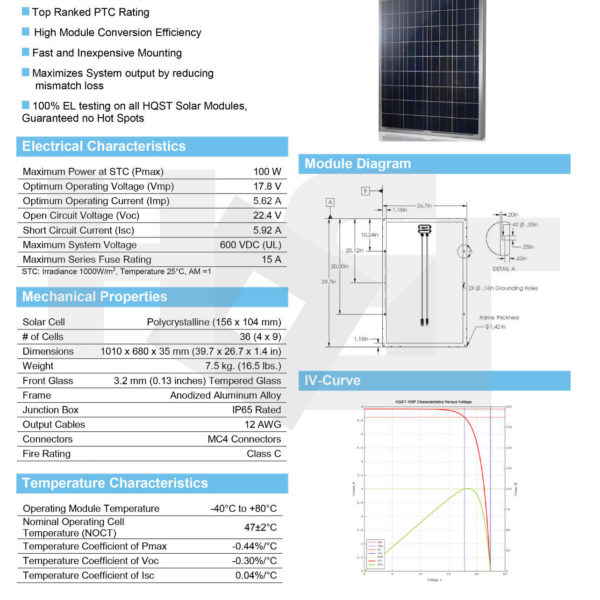This is an old revision of the document!
Table of Contents
Tweaking a PWM controller for maximum power
PWM controllers are inexpensive and durable. Their chief downside is they cannot generate as much power from a given panel as the more expensive MPPT can. This page is intended to help people get the most out of their PWM system. It assumes the 'dweller owns a configurable PWM controller.
Note: much of this information also applies to tweaking shunt controllers.
the controller's achilles heel
During charging with a PWM controller the solar panel will be running at the voltage of the battery bank. Unfortunately, this is almost never the voltage at which the panel makes its rated power (Vmp). The panel will make less and less power when battery voltage is low.
This affects charging in all three charging stages but it is devastating in Bulk. Let's do some math to see why.
 Consider the spec sheet for a random 100w panel (right). 100W is made when the panel is run at 17.8v (Vmp). The current will be around 5.6A (Imp) when the panel is in the usual operating range.
Consider the spec sheet for a random 100w panel (right). 100W is made when the panel is run at 17.8v (Vmp). The current will be around 5.6A (Imp) when the panel is in the usual operating range.
17.8v x 5.6A = 99.68w ←- full power, if we could run the panel there. Which we can't with PWM.
14.8v x 5.6A = 82.88w ←- power at a high Absorption voltage, as with flooded lead acid
14.4v x 5.6A = 80.64w ←- power at a lower Absorption voltage
14.2v x 5.6A = 79.52w ←- power at a low Absorption voltage
13.8v x 5.6A = 77.28W ←- power at high Float, as with deeply cycled banks
13.2v x 5.6A = 73.92W ←- power at low Float, as with lightly cycled banks
12.7v x 5.6A = 70.61W ←- power at 100% state of charge (SoC)
12.4v x 5.6A = 69.44W ←- power at 75% state of charge; bulk charging
12.1v x 5.6A = 67.76W ←- power at 50% state of charge; bulk charging
This last number shows how far off PWM output can fall when battery voltage is at its lowest.1) It's also when the battery needs the most current to get out of that deep cycle trough.
the plan
Here are steps to take to maximize power from the PWM controller, in order from greatest effect to least effect.
delay loads until after Bulk
During the bulk charging stage the battery needs every bit of power it can get. Any loads applied during this stage slow down charging and, more importantly, prevent the system from reaching power-making voltages as soon as possible.
Wait until your bank is well into Absoroption before using discretionary loads.
set Vabs and Vfloat relatively high
Since the panels make more power at higher voltages2) cranking up Vabs and Vfloat to higher-but-still-sane levels will result in more power being harvested.
battery: maintain a higher state of charge
This may seem obvious, but remember:
- since state of charge is correlated with voltage; and
- voltage is correlated with panel output; then
- keeping your bank as charged as possible will let the panels produce the most power for conditions
In other words, the lower your battery voltage gets the worse the system works. There are two courses of action to take that will help reduce this effect.
- Cycle less deeply - Instead of cycling to 50% state of charge (12.2v) consider cycling to only 75% SoC (12.4v).
- combine your solar charging with even small amounts of alternator or shore power charging. Either one of these will help get the bank “out of the mud”, particularly if they are added early in the morning.

